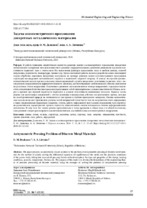| dc.contributor.author | Дьяконов, О. М. | |
| dc.contributor.author | Литвинко, А. А. | |
| dc.coverage.spatial | Минск | ru |
| dc.date.accessioned | 2024-02-06T10:06:45Z | |
| dc.date.available | 2024-02-06T10:06:45Z | |
| dc.date.issued | 2024 | |
| dc.identifier.citation | Дьяконов, О. М. Задача осесимметричного прессования дискретных металлических материалов = Axisymmetric Pressing Problem of Discrete Metal Materials / О. М. Дьяконов, А. А. Литвинко // Наука и техника. – 2024. – № 1. – С. 21-32. | ru |
| dc.identifier.uri | https://rep.bntu.by/handle/data/140898 | |
| dc.description.abstract | В работе приведено аналитически замкнутое решение задачи осесимметричного прессования дискретных металлических материалов методом совместного решения дифференциальных уравнений равновесия и условия пластичности пористого тела с учетом всех без исключения факторов прессования: вида и свойств шихты, условий нагружения, пористости, температуры, трения и др. Целью настоящей работы является разработка основ инженерной теории обработки давлением дискретных материалов на примере решения задачи осесимметричного прессования структурно-неоднородной металлической стружки в подвижной закрытой матрице. В основу построения физико-математической модели процесса положен идеализированный случай однородного уплотнения пористого тела с последующим определением коэффициента бокового давления, соответствующего действительной степени уплотнения на различных этапах нагружения. Полученное уравнение связи компонентов тензора напряжений с пределом текучести и относительной плотностью прессовки представляет собой цилиндрическое условие пластичности Мизеса, которое в пределе при нулевой пористости переходит в условие пластичности компактных металлов. Краевая задача решена для касательных напряжений с учетом величины и направления действия сил контактного трения, которые по своей физической природе не отличаются от сил трения в глубине прессуемого материала. Физико-математическая модель позволяет производить расчеты полей напряжений и плотности тела по координатам очага деформации, а также энергосиловых параметров (давление, усилие, работа деформации) при условии определения трех структурно-реологических характеристик: предела текучести, относительного сжатия и показателя степени деформационного уплотнения. В силу того что задача решена применительно к телам вращения в общем виде и в общей постановке, само решение следует рассматривать как методологическое для любой схемы осесимметричного нагружения. | ru |
| dc.language.iso | ru | ru |
| dc.publisher | БНТУ | ru |
| dc.title | Задача осесимметричного прессования дискретных металлических материалов | ru |
| dc.title.alternative | Axisymmetric Pressing Problem of Discrete Metal Materials | ru |
| dc.type | Article | ru |
| dc.identifier.doi | 10.21122/2227-1031-2024-23-1-21-32 | |
| local.description.annotation | The paper presents an analytically closed solution to the problem of axisymmetric pressing of discrete metal materials by the method of jointly solving the differential equations of equilibrium of the metal and the plasticity conditions of the porous body, taking into account all pressing factors without exception: the type and properties of the charge, loading conditions, porosity, temperature, friction, etc. The purpose of this work is to develop the foundations of the engineering theory of pressure processing of discrete materials using the example of solving the problem of axisymmetric pressing of structurally inhomogeneous metal chips in a movable closed matrix. The basis for constructing a physical and mathematical model of the process is the idealized case of uniform compaction of a porous body with the subsequent determination of the lateral pressure coefficient corresponding to the actual degree of compaction at various stages of loading. The resulting equation for the relationship between the stress tensor components and the yield stress and relative compaction density represents the cylindrical Mises plasticity condition, which in the limit at zero porosity transforms into the plasticity condition for compact metals. The boundary value problem is solved for tangential stresses, taking into account the magnitude and direction of action of contact friction forces, which in their physical nature do not differ from the friction forces in the depth of the pressed material. The physico-mathematical model makes it possible to calculate the stress fields and density of the body according to the coordinates of the deformation zone, as well as energy-power parameters (pressure, force, work of deformation) provided that three structural and rheological characteristics are determined: the yield strength, relative compression and the degree of deformation compaction. Due to the fact that the problem is solved in relation to bodies of rotation in a general form and in a general formulation, the solution itself should be considered as methodological for any axisymmetric loading scheme. | ru |

